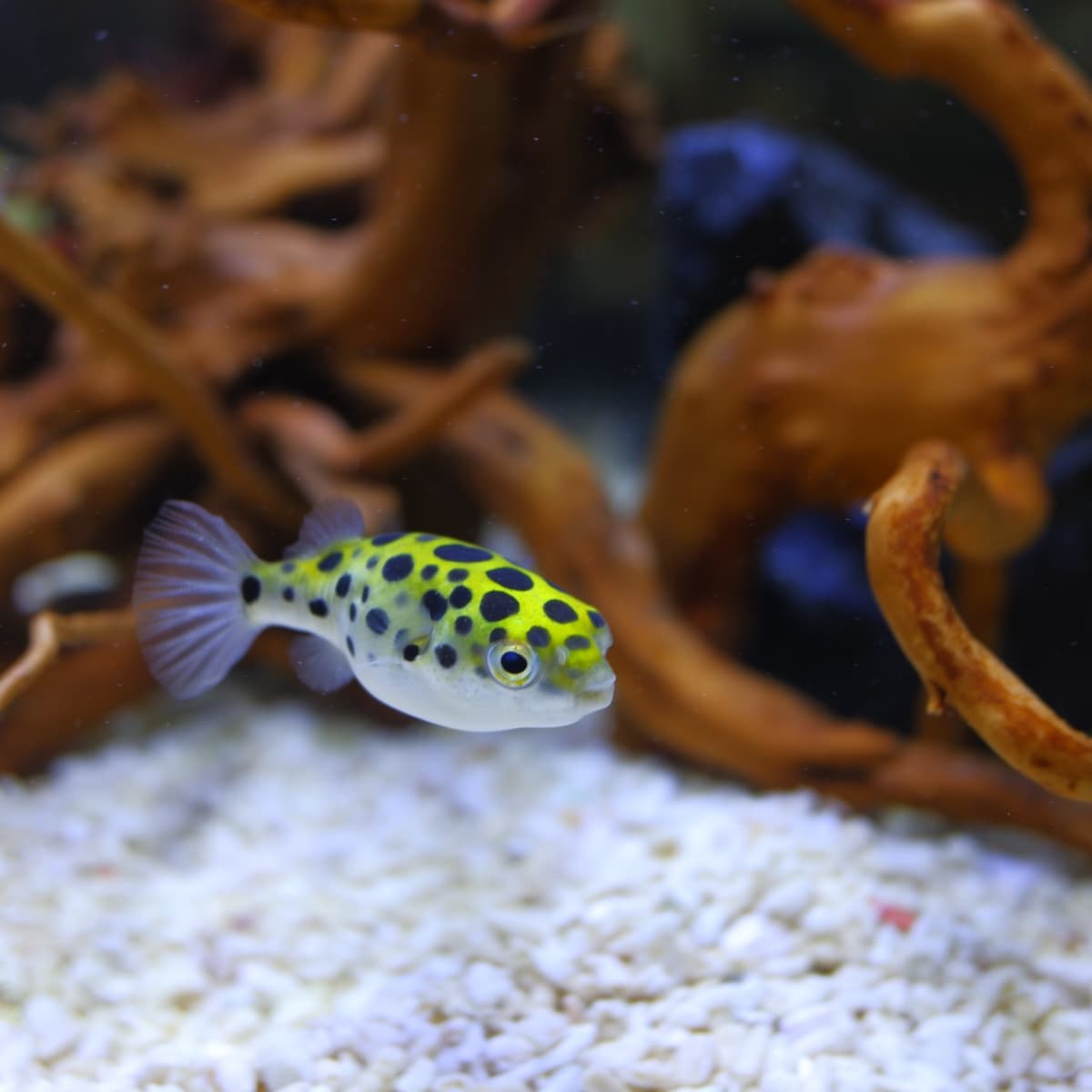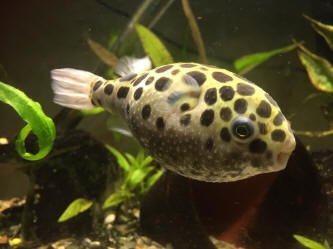Green Spotted Puffers often suffer from health problems like ich, fin rot, and internal parasites. These issues require prompt attention for effective treatment.
Green Spotted Puffers are unique and colorful aquarium fish, known for their intelligence and playful behavior. These fascinating creatures, native to brackish and freshwater environments, can be a joy to keep. However, their care requires attention to detail, especially concerning their health.
Common ailments include ich, a parasitic infection, fin rot, and internal parasites, which can severely impact their well-being. Maintaining a clean tank, providing a balanced diet, and regular health checks are essential for preventing these problems. Proper care ensures your Green Spotted Puffer remains healthy and vibrant, enhancing your aquarium experience.
.jpeg)
Credit: www.wetwebmedia.com
Common Health Issues
The Green Spotted Puffer (Tetraodon nigroviridis) is a beautiful fish. Yet, it is prone to several health problems. Knowing these issues helps in early detection and treatment. Below, we discuss two common health issues: Fin Rot and Ich.
Fin Rot
Fin Rot affects the fins and tail of your puffer fish. It is caused by bacteria or fungi. Stress and poor water quality often trigger this disease.
Symptoms of Fin Rot include:
- Frayed or ragged fins
- White edges on fins
- Red streaks in fins
- Fins appear to be melting away
To treat Fin Rot, follow these steps:
- Improve water quality by changing water regularly.
- Isolate the infected fish to prevent spreading.
- Use antibacterial medications as recommended by a vet.
- Maintain a clean tank environment.
Ich
Ich, also known as white spot disease, is another common issue. It is caused by a parasite. This parasite attaches to the fish’s skin, gills, and fins.
Symptoms of Ich include:
- White spots on the skin and fins
- Fish rubbing against objects
- Labored breathing
- Loss of appetite
To treat Ich, follow these steps:
- Raise the water temperature gradually.
- Add aquarium salt to the water.
- Use anti-parasitic medications as per vet’s advice.
- Quarantine new fish before adding them to the tank.
Maintaining a clean and stress-free environment is key to preventing these diseases. Regular water changes and monitoring can keep your Green Spotted Puffer healthy.
Signs Of Illness
Green Spotted Puffers, like all pets, can get sick. Knowing the signs of illness helps in taking quick action. Here, we discuss the key signs to watch out for.
Behavioral Changes
Changes in behavior can be the first sign of illness. Keep an eye out for these:
- Lethargy: Your puffer may seem less active.
- Loss of Appetite: Not eating as usual is a red flag.
- Erratic Swimming: Swimming in circles or upside down.
- Hiding More: Spending more time hiding than usual.
Physical Symptoms
Physical changes are often visible signs of illness. Look for these symptoms:
| Symptom | Description |
|---|---|
| White Spots | Could indicate ich or other parasitic infections. |
| Swollen Belly | May suggest internal parasites or bloating. |
| Discolored Patches | Skin discoloration can be a sign of stress or disease. |
| Clamped Fins | Fins held close to the body may indicate discomfort. |
Preventive Measures
Keeping your Green Spotted Puffer healthy requires attention to their environment and diet. Implementing preventive measures ensures they live long, happy lives. Let’s explore key areas to focus on.
Water Quality
Good water quality is vital for your Green Spotted Puffer’s health. Use a high-quality filter to keep the water clean. Regularly test the water for ammonia, nitrites, and nitrates. Ideal parameters include:
- Ammonia: 0 ppm
- Nitrites: 0 ppm
- Nitrates: Below 20 ppm
Perform a 25% water change weekly to maintain these levels. Ensure the water temperature stays between 24-28°C (75-82°F). Use a heater if needed. pH levels should be between 7.5 and 8.5.
Proper Diet
A balanced diet is essential for Green Spotted Puffers. They need a mix of protein and plant-based foods. Include the following in their diet:
- Frozen or live foods: Bloodworms, brine shrimp, and snails
- Vegetables: Peas and spinach
- High-quality pellets: Specially made for puffers
Feed them small amounts twice a day to prevent overfeeding. Remove uneaten food to keep the tank clean. Avoid feeding them the same food daily. Rotate their diet to ensure they get all necessary nutrients.

Credit: pethelpful.com
Treatment Options
Green Spotted Puffers can face various health problems. Knowing the right treatment options is crucial. This section will cover medications and quarantine procedures.
Medications
Medications can help treat many health issues in Green Spotted Puffers. Here are some common ones:
| Condition | Medication | Dosage |
|---|---|---|
| Ich | Copper-based medication | Follow package instructions |
| Bacterial Infections | Antibiotics | As prescribed by a vet |
| Fungal Infections | Antifungal treatments | Follow package instructions |
Always consult a vet before giving any medications to your puffer. Incorrect dosage can harm them. Keep a record of treatments given.
Quarantine Procedures
Quarantine is vital for new and sick puffers. It helps prevent the spread of diseases. Follow these steps:
- Set up a separate tank for quarantine.
- Ensure the tank has proper filtration and heating.
- Keep the water parameters stable.
- Observe the puffer for any signs of illness.
- Treat the puffer with appropriate medications if needed.
Quarantine should last at least two weeks. This ensures the puffer is healthy before joining others. Always sterilize equipment used in quarantine tanks.
These treatment options can help keep your Green Spotted Puffer healthy. Proper care and early intervention are key.
Dietary Recommendations
Green Spotted Puffers have unique dietary needs to stay healthy. Proper nutrition prevents common health issues. This section covers their nutritional needs and feeding schedule.
Nutritional Needs
Green Spotted Puffers are carnivores. They need a diet rich in protein. Some ideal foods include:
- Snails
- Crustaceans
- Bloodworms
- Shrimp
These foods help keep their teeth from overgrowing. Puffers need crunchy foods. It helps maintain their dental health.
Avoid feeding dry or flake foods. They lack essential nutrients. Live or frozen foods are better. They provide complete nutrition.
Feeding Schedule
Green Spotted Puffers should be fed daily. Smaller, more frequent meals are best. This mimics their natural eating habits. Overfeeding can lead to obesity and health problems.
Consider the following feeding schedule:
| Age | Frequency |
|---|---|
| Juveniles | 2-3 times a day |
| Adults | Once daily |
Monitor their eating habits. Ensure they eat all provided food. Remove any leftovers after feeding. This prevents water contamination.
Adjust their diet as they grow. Different life stages have different needs. Always provide fresh, high-quality food.
Environmental Factors
Green Spotted Puffers need special care. The environment in their tank is very important. Poor conditions can lead to serious health issues. Let’s discuss some critical factors.
Tank Size
Tank size is crucial for Green Spotted Puffers. They need space to swim. A small tank can stress them out. Stress can make them sick.
| Tank Size | Number of Puffers |
|---|---|
| 20 gallons | 1 puffer |
| 30 gallons | 2 puffers |
| 50 gallons | 3 puffers |
Always choose a larger tank if possible. A bigger tank means cleaner water. Clean water keeps puffers healthy.
Decor And Substrate
Decor and substrate also matter. Puffers like to explore. They need hiding spots. Use plants, rocks, and caves.
- Live plants
- Rocks and caves
- Sand substrate
Avoid sharp objects. Sharp objects can hurt puffers. Injuries can lead to infections.
Use sand instead of gravel. Puffers like to dig. Gravel can be harmful to them.
Ensure all decor is clean. Dirty decor can harbor bacteria. Bacteria can make puffers sick.
Stress Reduction
Stress is a major factor affecting the health of Green Spotted Puffers. Reducing stress can greatly improve their wellbeing. Proper tank mates and activity levels play crucial roles in stress reduction.
Tank Mates
Choosing the right tank mates is essential for reducing stress in Green Spotted Puffers. Aggressive or incompatible fish can cause stress and health problems.
- Pick non-aggressive fish.
- Avoid fin nippers.
- Ensure tank mates are of similar size.
Here is a table of good and bad tank mates:
| Good Tank Mates | Bad Tank Mates |
|---|---|
| Snails | Betta Fish |
| Ghost Shrimp | Angelfish |
| Mollies | Goldfish |
Activity Levels
Maintaining proper activity levels helps reduce stress in Green Spotted Puffers. These fish need space and enrichment.
- Provide a spacious tank.
- Include hiding spots.
- Add plants and decorations.
Interactive elements like toys can keep puffers engaged and reduce stress. Regular observation helps ensure they stay active and healthy.
Monitoring And Maintenance
Maintaining the health of your Green Spotted Puffer involves regular monitoring and consistent maintenance. These fish have specific needs and can be prone to health problems. Regular check-ups and proper equipment care are essential for their well-being.
Regular Check-ups
Regular health check-ups are crucial for your Green Spotted Puffer. Observe your fish daily for any signs of distress or illness. Look for changes in behavior, appetite, or appearance. Early detection can prevent serious health issues.
- Behavioral Changes: Watch for unusual swimming patterns or lethargy.
- Appetite: Note any changes in eating habits.
- Appearance: Check for spots, discoloration, or fin damage.
Equipment Care
Proper equipment care ensures a healthy environment for your puffer. Clean and maintain all equipment regularly to prevent disease.
| Equipment | Maintenance Frequency |
|---|---|
| Filter | Weekly |
| Heater | Monthly |
| Lighting | Every 6 months |
Regular water changes are vital. Replace 25% of the tank water weekly. Test water parameters to ensure they remain within safe levels. Use a reliable water testing kit.
- Ammonia: 0 ppm
- Nitrite: 0 ppm
- Nitrate: Under 20 ppm
- pH: 7.5 to 8.5
- Temperature: 75°F to 82°F (24°C to 28°C)
Following these guidelines helps maintain a healthy environment for your Green Spotted Puffer.
Credit: www.reef2reef.com
Frequently Asked Questions
Are Green Spotted Puffers Toxic?
Yes, green spotted puffers are toxic. They contain tetrodotoxin, which is harmful if ingested. Handle with care.
What Is The Lifespan Of A Green Spotted Puffer Fish?
A green spotted puffer fish typically lives for 10 years in captivity. Proper care and a suitable environment are crucial.
Are Green Spotted Puffers Hard To Take Care Of?
Green spotted puffers require specific care. They need brackish water, a varied diet, and regular tank maintenance. Proper care ensures their health.
Why Is My Spotted Puffer Not Eating?
Your spotted puffer may not be eating due to stress, poor water quality, illness, or an unsuitable diet. Check tank conditions and consult a vet.
Conclusion
Ensuring your green spotted puffer remains healthy is crucial. Regular water changes and proper diet can prevent many issues. Watch for signs of illness early. Prompt treatment can save your puffer’s life. Maintaining a clean tank and monitoring water parameters are essential.
Your puffer deserves a long, healthy life with your care.
